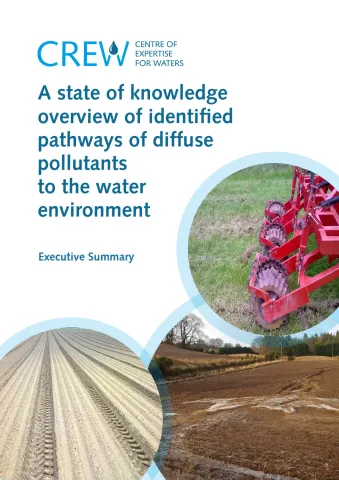Pathways of diffuse phosphorus and nitrogen pollution from agriculture to the water environment is complex and, sometimes, poorly understood. This report provides a review of the current state of knowledge of several plausible pathways: i) surface runoff and soil erosion, exacerbated by soil compaction and structural degradation ii) role of tramlines, iii) leaching through drain-flow and iv) hotspots that contribute greater than average pollutant loads due to the combined effect of land management intensity and soil properties. Focussing on Scotland we reviewed the relevant evidence for each of these pathways, their scale and extent, preventative measures and solutions to minimise pollutant losses, the costs and impacts on water quality associated with these preventative measures and solutions, as well as identifying key knowledge gaps and providing recommendations for future research.
Key findings from this overview concluded that standard agricultural practices are the main source of nitrogen and phosphorus pollution rather than poor nutrient management practices in Scotland. Spatial modelling showed that surface runoff and erosion are the principle source of phosphorus loss in arable soils while phosphorus loss through drains is also a key pathway, particularly in improved grasslands on soils with artificial drainage. Good soil nutrient management such as the use of a fertiliser plan linked to soil sampling for nutrient status and soil pH is a simple and cost-effective measure for minimising pollutant losses. Finally, it was found that more research is needed across all pathways and there are many knowledge gaps, particularly being able to quantify diffuse pollution from ‘hotspots’ in fields within Scottish catchments and our understanding of the impacts of recommended preventative measures and solutions on water quality.
Knowledge transfer products, including a podcast and video featuring farmers, a technical video and information sheets, have also been produced to communicate key messages about good soil management practices to farmers and landowners. These can be accessed from the Farming and Water Scotland website
| Attachment | Size |
|---|---|
| Executive Summary | 724.01 KB |
| CREW Diffuse Pollution Prevention Sheet | 3.82 MB |
| CREW Management Costs Sheets | 1.3 MB |
| CREW Decision Tree Guidance Sheet | 2.98 MB |
| CRW2018_18 Main Report | 4.79 MB |
